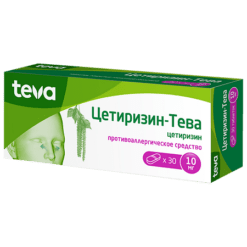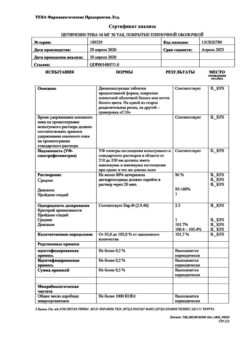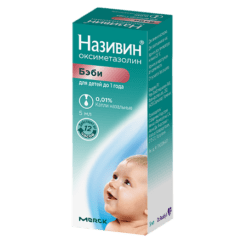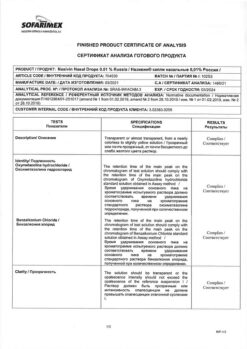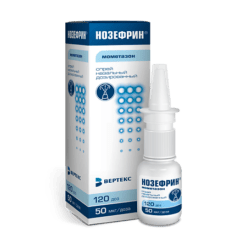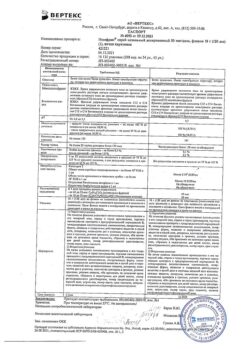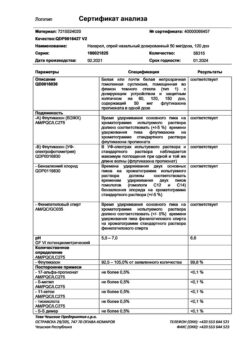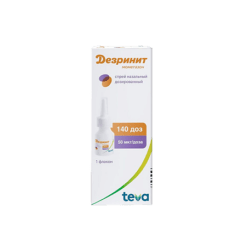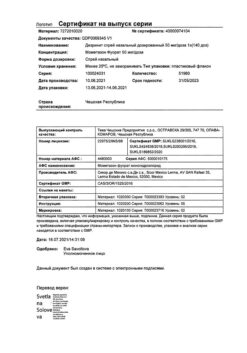No products in the cart.
Suprilamin, tablets 25 mg 20 pcs
€4.81 €4.01
Description
Pharmacotherapeutic group:
anti-allergic agent – H1-histamine receptor blocker
ATX code: R06AC03
Pharmacological properties
Pharmacodynamics
Chloropyramine, a chlorinated analog of tripelenamine (pyribenzamine), is a first-generation antihistamine drug belonging to the group of ethylenediamine antihistamines.
A blocker of H1-histamine receptors, it has antihistamine and m-cholin-blocking effects. This drug also acts on smooth muscles, on capillary permeability and on the central nervous system (CNS).
When taken orally, the effect occurs as early as 15-30 minutes, the maximum effect develops within 1 hour and lasts for about 3-6 hours.
Pharmacokinetics
Intake
In oral administration, it is almost completely absorbed from the gastrointestinal tract (GIT). The therapeutic effect of chloropyramine develops within 15-30 minutes after oral administration, reaches its maximum within the first hour after administration and lasts for at least 3-6 hours.
Distribution
It is well distributed in the body, including the CNS.
Metabolism
Intensively metabolized in the liver.
Elimination
Extracted mainly by the kidneys as metabolites.
Particular patient populations
Children and adolescents
The drug is eliminated faster in children than in adult patients.
Patients with impaired liver function
In patients with impaired liver function, the metabolism of chloropyramine is decreased, so the dose of the drug may be reduced.
Patients with impaired renal function
In patients with impaired renal function, the excretion of chloropyramine is decreased, so the dose of the drug may be reduced.
Indications
Indications
Urticaria, serum sickness, seasonal and year-round allergic rhinitis, allergic conjunctivitis, contact dermatitis, pruritus, acute and chronic eczema, atopic dermatitis, food and drug allergies, allergic reactions to insect bites.
Pharmacological effect
Pharmacological effect
Pharmacotherapeutic group:
antiallergic agent – H1-histamine receptor blocker
ATX code: R06AC03
Pharmacological properties
Pharmacodynamics
Chloropyramine, a chlorinated analogue of tripelenamine (pyribenzamine), is a first-generation antihistamine that belongs to the group of ethylenediamine antihistamines.
A blocker of H1-histamine receptors, has an antihistamine and m-anticholinergic effect. This drug also acts on smooth muscle, capillary permeability, and the central nervous system (CNS).
When taken orally, the effect appears within 15-30 minutes, the maximum effect develops within 1 hour and lasts approximately 3-6 hours.
Pharmacokinetics
Suction
When taken orally, it is almost completely absorbed from the gastrointestinal tract (GIT). The therapeutic effect of chloropyramine develops within 15-30 minutes after oral administration, reaches a maximum within the first hour after administration and lasts at least 3-6 hours.
Distribution
Well distributed in the body, including the central nervous system.
Metabolism
Intensively metabolized in the liver.
Removal
It is excreted mainly by the kidneys in the form of metabolites.
Special patient populations
Children and teenagers
In children, drug elimination occurs faster than in adult patients.
Patients with liver dysfunction
In patients with impaired liver function, the metabolism of chloropyramine is reduced, so the dose of the drug may be reduced.
Patients with impaired renal function
In patients with impaired renal function, the excretion of chloropyramine is reduced, so the dose of the drug may be reduced.
Special instructions
Special instructions
Use of chloropyramine in the late evening hours may increase the symptoms of gastroesophageal reflux disease.
When combined with ototoxic drugs, chloropyramine may mask early signs of ototoxicity.
Diseases of the liver and kidneys may require a change (reduction) in the dose of the drug, and therefore the patient should inform the doctor about the presence of liver and kidney disease.
Due to its anticholinergic and sedative effects, chloropyramine should be administered with caution to elderly patients, patients with impaired liver function, cardiovascular disease, angle-closure glaucoma, urinary retention and prostatic hyperplasia.
Chloropyramine can enhance the effect of alcohol on the central nervous system, and therefore the consumption of alcoholic beverages is prohibited while taking the drug.
Long-term use of antihistamines can lead to disorders of the blood system and hematopoiesis (leukopenia, agranulocytosis, thrombocytopenia, hemolytic anemia). If during long-term use there is an unexplained increase in body temperature, laryngitis, pallor of the skin, jaundice, the formation of ulcers in the mouth, the appearance of hematomas, unusual and long-lasting bleeding, it is necessary to conduct a clinical blood test to determine the number of formed elements. If the test results indicate a change in the blood formula, stop taking the drug.
Each tablet contains 130 mg of lactose monohydrate. The drug is contraindicated in patients with lactase deficiency, lactose intolerance, glucose/galactose malabsorption.
Impact on the ability to drive vehicles and machinery
The drug, especially in the initial period of treatment, may cause drowsiness, fatigue and dizziness. Therefore, in the initial period, the duration of which is determined individually, driving vehicles or performing work associated with an increased risk of accidents is prohibited. After this, the degree of restriction on driving vehicles and operating machinery must be determined by the doctor individually for each patient.
Active ingredient
Active ingredient
Chloropyramine
Composition
Composition
Active ingredient: chloropyramine hydrochloride – 25.0 mg
Excipients: lactose monohydrate (milk sugar), microcrystalline cellulose, sodium carboxymethyl starch (sodium starch glycolate, Primogel), povidone K25 (kollidon K25), magnesium stearate.
Pregnancy
Pregnancy
Pregnancy
There have been no adequate controlled clinical studies of the use of antihistamines in pregnant women. However, cases of retrolental fibroplasia have been described in newborns whose mothers took antihistamines in the last months of pregnancy. Accordingly, the use of chloropyramine during pregnancy is contraindicated.
Breastfeeding
The use of chloropyramine is contraindicated during breastfeeding.
If it is necessary to use the drug during lactation, breastfeeding should be stopped.
Contraindications
Contraindications
Hypersensitivity to chloropyramine and other components of the drug, acute attack of bronchial asthma, lactose intolerance, lactase deficiency or glucose-galactose malabsorption, pregnancy, lactation, children under 3 years of age (for this dosage form).
With caution
Angle-closure glaucoma, urinary retention, prostatic hyperplasia, impaired liver and/or kidney function, cardiovascular disease in elderly patients.
Side Effects
Side Effects
Side effects, as a rule, occur extremely rarely, are temporary, and disappear after discontinuation of the drug.
Side effects are presented according to the damage to organs and organ systems in the sequence of the Medical Dictionary for Regulatory Activities (MedDRA).
There are no clinical studies to establish the frequency of adverse reactions.
Disorders of the blood and lymphatic system: leukopenia, agranulocytosis, hemolytic anemia and other changes in the cellular composition of the blood (for example, thrombocytopenia with long-term use of the drug).
Immune system disorders: allergic reactions.
Nervous system disorders: drowsiness, fatigue, dizziness with a sensation of spinning (vertigo), nervous agitation, ataxia, tremor, headache, euphoria, convulsions, encephalopathy.
Visual disturbances: blurred vision, attacks of glaucoma, increased intraocular pressure.
Cardiovascular system disorders: decreased blood pressure, tachycardia, arrhythmia.
Gastrointestinal disorders: abdominal discomfort, dry mouth, nausea, vomiting, diarrhea, constipation, loss or increase of appetite, pain in the upper abdomen.
Musculoskeletal and connective tissue disorders: myopathy.
Renal and urinary tract disorders: difficulty urinating, urinary retention.
Skin and subcutaneous tissue disorders: photosensitivity.
If any of the above effects occur, stop taking the drug and consult a doctor immediately.
Reports of side effects
If you experience any of the side effects listed in the instructions, or they get worse, or you notice any other side effects not listed in the instructions, tell your doctor.
In the post-registration period, any information about possible adverse reactions is important, since these reports help evaluate the safety of the drug. Healthcare workers are required to report any suspected adverse reactions to the contacts indicated at the end of the instructions, as well as to local pharmacovigilance authorities.
Interaction
Interaction
Monoamine oxidase inhibitors enhance and prolong the anticholinergic effects of chloropyramine.
Particular caution should be exercised when simultaneous use of chloropyramine tablets with barbiturates, hypnotics, anxiolytic and sedatives, tranquilizers, opioid analgesics, tricyclic antidepressants, atropine, muscarinergic parasympatholytics (chloropyramine and any of these drugs may enhance each other’s effects).
During treatment, the consumption of alcoholic beverages is prohibited (alcohol enhances the inhibitory effect of chloropyramine on the central nervous system).
When combined with ototoxic drugs, chloropyramine may mask early signs of ototoxicity.
Antihistamines suppress skin reactions in response to allergic skin tests, so chloropyramine should be discontinued several days before skin testing.
Overdose
Overdose
Overdose of antihistamines, especially in children, can be fatal, especially in infants.
Symptoms: In overdose, chloropyramine causes symptoms similar to atropine poisoning, such as hallucinations, anxiety, ataxia, incoordination, athetosis, convulsions. In young children, excitement predominates. Sometimes dry mouth, fixed pupil dilation, facial skin flushing, sinus tachycardia, urinary retention, and fever occur. In adults, fever and facial flushing may be absent; a period of agitation is followed by convulsions and postconvulsive depression with the possible development of coma and cardiovascular and respiratory failure, which can lead to the death of the patient within 2-18 hours.
Treatment: Due to the anticholinergic effect of this drug, gastric emptying is slowed down. Thus, inducing vomiting, gastric lavage and administration of activated charcoal are recommended within 12 hours of an overdose. Monitoring of indicators of the cardiovascular and respiratory systems and symptomatic therapy are recommended.
A specific antidote is unknown.
Storage conditions
Storage conditions
In a place protected from light at a temperature not exceeding 25 °C.
Keep out of the reach of children.
Shelf life
Shelf life
3 years. Do not use after expiration date.
Manufacturer
Manufacturer
Velfarm LLC, Russia
Additional information
| Shelf life | 3 years. Do not use after the expiration date. |
|---|---|
| Conditions of storage | In the dark place at a temperature not exceeding 25 ° C. Keep out of reach of children. |
| Manufacturer | Welfarm, Russia |
| Medication form | pills |
| Brand | Welfarm |
Related products
Buy Suprilamin, tablets 25 mg 20 pcs with delivery to USA, UK, Europe and over 120 other countries.





